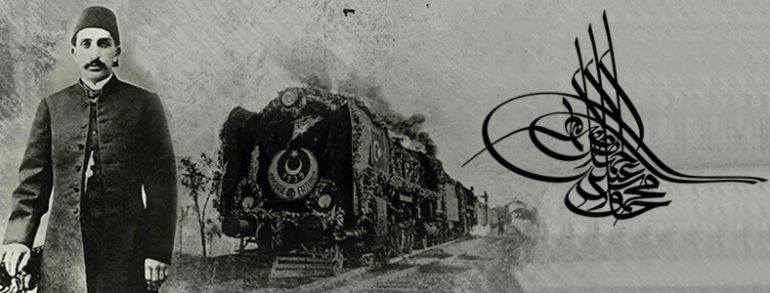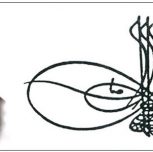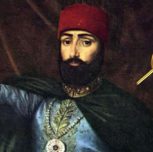(1842, 1876-1909, 1918)
In 1876, when Alexander Graham Bell filed the first patent to use the telephone as a practical instrument in the USA, and the German composer and pianist Johannes Brahms introduced the Symphony No. 1 for the first time to his audience in Europe the Ottoman Empire had a new sultan on the throne, Abdülhamid II. He served in one of the most critical periods in Ottoman history.
Born on 22 September 1842, Abdülhamid II was a son of Sultan Abdülmecid. He lost his mother, Tîr-î-Müjgan Kadın Efendi (1819-1853), at the age of 11, therefore he was raised by his stepmother Valide Sultan Rahime Piristû. Since the biological mother of Abdülhamid II had died 23 years before Sultan Abdülhamid II's accession to the throne, the position of “Valide Sultan” was given to Rahime Piristû by Abdülhamid II.
Abdülhamid II was 34 years old, when he became the 34th sultan of the Ottoman Empire on 31 August 1876. Ahmed Necib Paşa (1812-1883) composed the “Hamidiye Marşı” for the new sultan. Since the Ottoman Empire did not have any national anthem, each sultan had their own personal marches performed during their reigns.
He was the last Ottoman sultan having full imperial power and the title of Caliph, as he demolished the parliament right after its first meeting on 23 December 1876. The parliament was reopened on 24 July 1908, and the political system of the Ottoman Empire was permanently changed to a “constitutional monarchy”. The subsequent sultans shared their authority with the parliament.
During the reign of Sultan Abdülaziz (1861-1876), Abdülhamid was the second crown prince in the empire and was never expected to be a sultan. Therefore, he extensively enjoyed the freedom of traveling, doing business, reading and socializing. Abdülhamid was well educated and had an excellent memory. He learned economy, finance, history, diplomacy and even invested in equities on his own. He traveled to Egypt and visited London, Paris and Vienna with Sultan Abdülaziz, his uncle. His wit and talent contributed to his remaining in power for 33 years.
He liked animals, especially horses, cats and pigeons. Watching plays and operas in his private theater was his major form of entertainment. He created his own world within the walled palace.
After the dethronement of Abdülaziz, Sultan Murad V (1876), who was Abdülhamid’s younger uncle and the first crown prince, became the 33th Sultan in the Ottoman Empire, but his reign lasted for only three months. Then, Abdülhamid unexpectedly found himself as the 34th Sultan of the Ottoman Empire in 31 August 1876.
During the reign of Abdülhamid II, there were many developments globally. Paraffin stoves were first introduced to the public in 1878, and over half a million were sold within the next decade. The popular decorative arts and architecture style of “Art Nouveau” (new art), inspired by the natural forms, dominated Europe and the USA from 1880 until 1910. The Eiffel Tower was erected in 1889.
The wide-open Dolmabahçe Palace on the shore of the Bosphorus did not fit the traditional Ottoman palace system of walled-courts, like the ones in Topkapi and Edirne. Abdülhamid II, therefore, moved the empire from Dolmabahçe Palace to the Yildiz Palace within the first year of his reign, in 1877.
In the same year, Abdülhamid II found himself in the middle of the Turkish-Russian War of 1877–1878. After the war, not only did he lose a big piece of land, but he also lost so much money that the debt burden of the treasury reached an astronomical level which ended with a moratorium. To guarantee the repayments of the foreign debt, the tax revenues of the six domestic products were left to the control of the "Ottoman Public Debt Administration" (Düyun-u Umumiyye) (1881-1939), managed by the representatives of the lending countries.
The Sublime Porte (Bâb-ı Âli), located across from the Procession Pavilion (Alay Köşkü) in the Gülhane Park of the Topkapi Palace complex, was the center of the administrative offices of the grand vizier (prime minister) since 15th century. After the move, the Sublime Porte was subordinated, as the Sultan collected all the power in his palace and established a strong authority in the government. His new administration was then called “Yildiz Palace”, instead of Sublime Porte.
He also stayed distant from the public. Apart from his visits to Dolmabahçe Palace twice a year and to Topkapi Palace once a year in religiously important days, he did not appear in public. He watched his people from the palace, hidden from sight. He followed his people without their knowledge to control them. Therefore, the Yildiz Palace fit his personality and governing style.
His Final Years
Abdülhamid did not like theater ending sadly. Therefore, it is rumored that, art directors changed the sad endings of the plays performed in his imperial theater in the palace. Nevertheless, he was unable to change his own ending. His 33-year-reign ended on 27 April 1909. Abdülhamid was exiled to Thessaloniki (today part of Greece) for a house arrest. When he returned to İstanbul, he lived out his years in Beylerbeyi Palace, another imperial residence on the Asian shore of the Bosphorus, opposite the Yıldız Palace.
Sultan Abdülhamid II died on 10 February 1918 at the age of 75 in the Beylerbeyi Palace. He was buried in the Mausoleum of Mahmud II (2. Mahmud Türbesi), where his uncle Sultan Abdülaziz and his grandfather Sultan Mahmud II were also buried in 1876 and 1839, respectively. The octagonal mausoleum (türbe) with marble exterior is located in the Çemberlitaş neighborhood of the Eminönü District in Istanbul.










